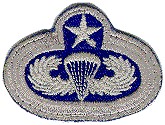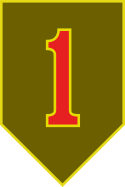11th Airborne Division (Vereinigte Staaten)

Die 11th Airborne Division (deutsch 11. US-Luftlandedivision), die auch Arctic Angels genannt wird, ist eine Luftlandedivision der United States Army, die am 25. Februar 1943 in Camp Mackall unter dem Befehl von Generalmajor Joseph W. Swing aufgestellt wurde. Sie trug im Zweiten Weltkrieg maßgeblich zu der Befreiung der philippinischen Insel Luzon von der japanischen Besatzung bei und wurde nach dem Krieg in Japan und später in Deutschland stationiert. 1958 wurde sie aufgelöst und einige Jahre später von der 11th Air Assault Division ersetzt, die wiederum 1965 aufgelöst wurde. 2022 wurde sie in Alaska als ein auf arktischer Kriegsführung spezialisierte Luftlandeverband wieder aufgestellt.
Geschichte
Zweiter Weltkrieg
Die 11. US-Luftlandedivision erreichte, nachdem sie von San Francisco aus eingeschifft worden war, am 25. Mai 1944 Neuguinea, wo sie bis November 1944 trainierte. Das Augenmerk lag dabei auf neuen Taktiken wie die Kriegsführung im Urwald, aber auch auf den Kernfähigkeiten, daher erfolgten mehrere Absprünge. Am 11. November 1944 verließ die Division Neuguinea wieder in Richtung Philippinen. Sie landete am 18. November desselben Jahres amphibisch – also nicht aus der Luft – zwischen Abuyog und Tarragona, 40 Meilen südlich von Tacloban, auf der Insel Leyte, und stieß ins Landesinnere vor. Dabei wurde der Nachschubweg der Japaner zwischen Ormoc und Burauen, eine wichtige japanische Kampflinie, erobert. Die Hauptaufgabe der Division war es, einerseits alle Ausgänge aus den Bergen in das Tal von Leyte zu erobern und zu sichern, andererseits die Bergausgänge in den westlichen Küstenabschnitt zu sichern, um den Angriff der 7th Infantry Division auf Ormoc zu unterstützen.

Am 6. Dezember 1944 kämpften die Fallschirmjäger der 11. US-Luftlandedivision gegen japanische Fallschirmjäger, die nahe der Landebahn von San Pablo gelandet waren. Die japanischen Einheiten wurden innerhalb von fünf Tagen aufgerieben. In einer Serie von Kämpfen wurde der japanische Widerstand Ende Dezember in Leyte gebrochen. Die starke feindliche Stellung am Rock Hill konnte am 18. Dezember überwunden werden. Im Januar 1945 sammelte die Division neue Kräfte und bereitete sich auf eine Landung auf Luzon vor. Während andere amerikanische Truppen am 31. Januar 1945 Manila von Norden her angriffen, landete die 11. US-Luftlandedivision amphibisch bei Nasugbu, 60 Meilen südlich von Manila, und rückte von dort aus auf die philippinische Hauptstadt vor.
Der erste Sprung eines Verbands der Division im Zweiten Weltkrieg – der des 511. Fallschirm-Infanterieregiments auf dem Bergrücken von Tagaytay, am 3. Februar – traf auf keine Gegenwehr. Das 511. Regiment überquerte am 5. Februar den Fluss Paranaque und erreichte Manila. Dort verteidigten sich die Japaner erneut mit aller Verbissenheit. Am 12. Februar nahm die Division Nichols Field ein und flankierte vom 12. bis zum 16. Februar Fort McKinley, das sie am 17. Februar einnehmen konnte. Am 23. Februar wurden mehr als 2.000 amerikanische und europäische Kriegsgefangene, die in Los Banos gefangen waren, durch einen kombinierten Luft- und Seeangriff befreit. Nachdem Manila befreit worden war, durchbrach die Division einen starken Ring von feindlichen Stellungen um Lake Taal und Laguna de Bay und nahm am Highway No. 1 gelegene Städte ein. Im April hoben die 11. US-Luftlandedivision und andere Einheiten noch kleinere Widerstandsnester in der Provinz Batangas aus. Am 1. Mai war jeglicher Widerstand im Süden Luzons gebrochen.

Die letzte Operation der Division wurde am 23. Juni 1945, zusammen mit dem Vormarsch der 37th Infantry Division im Norden Luzons, ausgeführt. Eine neugebildete Spezialeinheit sprang über dem Flugfeld von Camalaniugan ab. Nach einer sofortigen Attacke gegen die dort liegenden Japaner konnte die Division am 26. Juni zwischen Alcala und dem Fluss Paret zur 37th Division aufschließen. Nachdem die Division im Juli 1945 trainierte, wurde sie nach der Kapitulation Japans am 30. August desselben Jahres nach Honshū ausgeflogen, um dort als erste amerikanische Einheit in einer Luftlandeaktion den Atsugi-Flughafen bei Tokio und den Hafen von Yokohama zu besetzen.
Nachkriegszeit

Nach Erledigung des gestellten Auftrags in Japan kehrte die Division 1949 als Ausbildungstruppe nach Camp Campbell in Kentucky zurück. Der letzte überseeische Einsatz der Division begann im Jahre 1956, als sie die 5. US-Infanteriedivision in Westdeutschland (bei der 7. US-Armee, VII. Korps) im Rahmen der Gyroscope-Truppenrotation ersetzte. Sie war wie ihr Vorgänger in Augsburg (Sheridan- und Reese-Kaserne) und in der näheren Umgebung am Flugplatz Gersthofen-Gablingen sowie in München stationiert und wurde nach der neuen, für den Atomkrieg vorgesehenen Pentomic-Struktur organisiert. Während dieser Zeit führte sie in Augsburg die ersten Fallschirmspringerlehrgänge für die neu aufgestellte Luftlandetruppe der Bundeswehr durch und bildete das Lehrpersonal der Luftlande- und Lufttransportschule aus. Mitte 1958 wurde die 11. US-Luftlandedivision in Augsburg und München durch die 24. US-Infanteriedivision ersetzt[1]; zur Zeit dieser Umstellung war der Verband an der US-Intervention im Libanon beteiligt. Die Luftlande-Elemente der 24. US-Infanteriedivision wurden bis 1959 ausgetauscht.
1963 wurde die 11th Air Assault Division (Test), die viele der Mitglieder der 11. US-Luftlandedivision aufnahm, in Fort Benning gegründet, um Hubschrauberangriffstaktiken zu testen. Ihr Kommandeur wurde Generalmajor Harry W. O. Kinnard, der während des Zweiten Weltkrieges bereits als Stabschef in der 101st Airborne Division gedient hatte. Mit der Auflösung der 11th Air Assault Division (Test) 1965 wurde das Konzept der luftbeweglichen Infanterie wurde von der 1st Cavalry Division und heute von der 101st Airborne Division weitergeführt.
Am 6. Juni 2022 wurde die Division in Alaska wieder reaktiviert. Sie übernahm zwei Brigaden der 25. US-Infanteriedivision. In Zukunft soll sie zu einem Großverband für die arktische Kriegsführung aufgebaut und ausgebildet werden.[2]
Organisation
- Headquarters Company, (Stabskompanie), ehemaliges United States Army Alaska
- Northern Warfare Training Center
- 1st Infantry Brigade Combat Team, stationiert in Fort Wainwright, Alaska
- 2th Infantry Brigade Combat Team (Airborne), stationiert in Fort Richardson, Alaska
Kommandeure
- Generalmajor Joseph M. Swing (25. Februar 1943 bis Februar 1946)
- Brigadegeneral Frank Dorn (Februar 1946 bis Juni 1946)
- Generalmajor Joseph M. Swing (Juni 1946 bis Januar 1948)
- Generalmajor William M. Miley (24. Januar 1948 bis Januar 1950)
- Generalmajor Lyman L. Lemnitzer (Januar 1950 bis November 1951)
- Generalmajor Wayne C. Smith (November 1950 bis Januar 1952)
- Generalmajor Ridgely Gaither (Februar 1952 bis März 1953)
- Generalmajor Wayne C. Smith (Mai 1953 bis Mai 1955)
- Generalmajor Derrill McDaniel (Juni 1955 bis September 1956)
- Generalmajor Hugh P. Harris (Oktober 1956 bis April 1958)
- Generalmajor Ralph Cooper (1958 bis Juni 1958)
- Generalmajor Harry W. O. Kinnard (1963 bis 1965 (Kommandeur der 11th Air Assault Division (Test)))
- Generalmajor Brian Eifler (seit Juni 2022)
Literatur
- E. M. Flanagan Jr.: The Angels: A History of the 11th Airborne Division. – Novato, CA, USA: Presidio Press, 1989. – ISBN 0-89141-358-8
Weblinks
- The 11th Airborne during World War II auf ww2-airborne.us (englisch)
- 11th Airborne Division Combat Chronicle auf history.army.mil (englisch)
- Leo Kocher (511 PIR): History of the 11th Airborne Division auf thedropzone.com (englisch)
Einzelnachweise
- ↑ usarmygermany.com; vgl.: "7th Army Major Units" (eingesehen am 6. Juli 1958)
- ↑ Steve Beynon: New Army 11th Airborne Division Gets Stand Up Date, Force Outline. In: www.military.com. 18. Mai 2022, abgerufen am 6. Juli 2022 (englisch).
Auf dieser Seite verwendete Medien
4th Infantry Division shoulder insignia :
I created this work during the course of my official duties. As a United States Army soldier, it is considered the work of the United States Federal Government, and as such is in the public domain. -- Steven Williamson (HiB2Bornot2B) - talk 15:49, 26 July 2007 (UTC)
Autor/Urheber: Diese W3C-unbestimmte Vektorgrafik wurde mit Inkscape erstellt ., Lizenz: CC BY-SA 3.0
The shoulder sleeve insignia of 2d Stryker Cavalry Regiment
The official logo of the United States Army (USA). It can be seen on the official United States Army website in September 2001.
US 1st Cavalry Division
SHOULDER SLEEVE INSIGNIA
- Description: On a yellow triangular Norman shield with rounded corners 5 1/4 inches in height overall, a black diagonal stripe extending over the shield from upper left to lower right and in the upper right a black horse's head cut off diagonally at the neck all within a 1/8 inch green border.
- Symbolism: Yellow, the traditional cavalry color, and the horse's head refer to the division's original cavalry structure. Black, symbolic of iron, alludes to the transition to tanks and armor. The black diagonal stripe represents a sword baldric and is a mark of military honor; it also implies movement "up the field" and thus symbolizes aggressive elan and attack. The one diagonal bend, as well as the one horse's head, also alludes to the division's numerical designation.
- Background: The shoulder sleeve insignia was originally approved January 3, 1921 with several variations in colors of the bend and horse's head to reflect the subordinate elements of the division. The current design was authorized for wear by all subordinate elements of the division on December 11, 1934 and previous authorization for the variations was cancelled.
3rd Infantry Division Shoulder Sleeve Insignia
1st Infantry Division Combat Service Identification Badge
75th Ranger Regiment Distinctive Unit Insignia
25th Infantry Division Shoulder Sleeve Insignia
The 11th Armored Cavalry Regiment Shoulder Patch
The official insignia for the 11th Airborne Division. The Army will re-designate U.S. Army Alaska and two Alaska-based brigade combat teams this summer as the 11th Airborne Division Headquarters and the 1st and 2nd Brigade Combat Teams, 11th Airborne Division. This re-designation is an outgrowth of the Army’s January 2021 Arctic Strategy and sets us on the path towards a force that is more appropriately manned, trained, and equipped for the Arctic environment.
Shoulder Sleeve Insignia of the United States Army Special Operations Command.
Description: On a red stylized spearhead with a 1/8 inch red border, 3 1/2 inches in height and 2 inches in width overall, a black Fairbairn-Sykes dagger. A black tab with "AIRBORNE" in red letters is attached above the insignia.
Symbolism: The stylized spearhead alludes to the shoulder sleeve insignia worn by the lst Special Service Forces and signifies the heritage and traditions that the US Army Special Operations Command will perpetuate. The unsheathed black dagger symbolizes total military preparedness and has long been associated with Army special operation forces. The airborne tab designates the command's airborne status.
Background: The shoulder sleeve insignia was approved effective 1 December 1989.Shoulder Patch of 173rd Airborne Brigade
3rd Armored Regiment Shoulder Sleeve Insignia
1st Special Forces Operational Detachment Delta Unit Patch
US Army 1st Armored Division Shoulder Sleeve Insignia
- Upon a five pointed white star whose points lie in the circumference of an imaginary circle 3-1/2 inches (8.89 cm) in diameter a Native American's head with war bonnet in profile, face red, bonnet blue with outline of feathers in blue.
- The star to be superimposed upon a black shield, of dimensions such that the points of the star shall lie at a distance of 1/8 inch (.32 cm) from the perimeter.
Symbolism:
- The star has played an important part in our history from the days of the Colonies to the present time.
- The Native signifies the first and original American.
- These devices were originally established by the division to use as vehicle markings and to identify the vehicles as all American.
Background:
- The shoulder sleeve insignia was originally authorized for the 2d Division on 6 Nov 1918, officially announced by The Adjutant General letter, 21 Jun 1922, amended to correct the description on 7 Nov 1927 and redesignated for the 2d Infantry Division on 1 Aug 1942.
Work of Federal Government
Shoulder sleeve patch of the U.S. 10th Mountain Division The 10th Mountain shoulder patch consists of a white-bordered powder keg. The powder keg is in blue and, superimposed on it are two red bayonets in saltire so as to form the Roman numeral “X”. The bayonets represent the Infantry and the numerical designation of the Division. This is the Shoulder Sleeve Insignia; the Distinctive Unit Insignia can be found at Image:10th Mountain Division-distinctive unit insignia.jpeg.
On a blue powder keg-like background, with a white border, two bayonets in saltire throughout scarlet fimbriated white. The blue background and the bayonets are symbolic of infantry while the position of the bayonets in saltire simulates the numerical designation of the organization.Karte der Philippinen






















